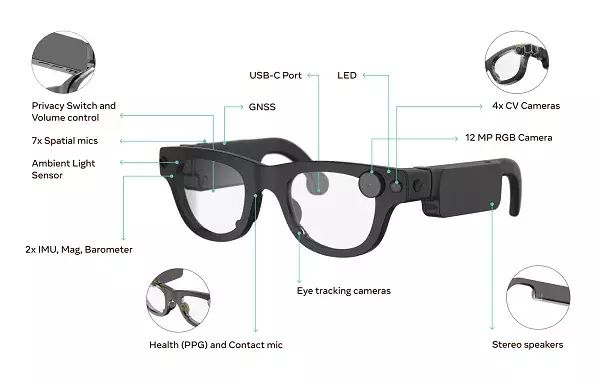Meta is gearing up for a monumental shift in how we perceive and interact with the digital world through its upcoming augmented reality (AR) glasses, the second generation of the aptly named “Aria.” As virtual and augmented experiences become integral to our daily lives, Meta’s latest technological innovations promise to provide a more immersive and accessible interaction platform. The proactive steps taken towards refining the design and functionality of the Aria Gen 2 reveal Meta’s commitment to ensuring that these glasses transcend merely being tech novelties. Instead, they strive to embed themselves into the fabric of everyday interactions.
Science Meets Stylish Design
What sets the Aria Gen 2 apart is Meta’s meticulous attention to aesthetics and wearability. Weighing between 74 and 76 grams, they are intentionally crafted to be lightweight without compromising on technology. The introduction of folding arms not only showcases innovative engineering but also addresses practical concerns regarding portability—certainly a thoughtful addition for users who might find themselves on the go. Furthermore, the fact that there are eight different sizes to choose from demonstrates an understanding of human diversity, moving away from the “one size fits all” concept. This is an essential step in making AR technology accessible and user-friendly; after all, comfort plays a crucial role in adoption.
Inside the Tech: Sensors and Tracking
Delving deeper into the specifications, the advancement in camera sensors is particularly noteworthy. Meta notes that these sensors can perform optimally under varying light conditions, a pivotal feature considering the outdoor nature of many potential AR applications. The enhanced field of view allows users to immerse themselves more fully in their augmented experiences, marking a stark evolution from previous iterations. Moreover, the addition of embedded microphones in the nosepad for improved audio capture signifies Meta’s understanding of the holistic nature of AR interaction. Users will no longer struggle to convey information in noisy environments, thereby enhancing communication across a multitude of settings—from busy streets to crowded rooms.
Furthermore, the integration of eye and hand tracking capabilities represents Meta’s push towards creating a reactive and intuitive interaction model. This feature not only streamlines the user experience but also opens the door for novel applications that could redefine how we communicate with digital systems. The notion of “talking to oneself,” as users engage with virtual interfaces, is an amusing yet vital phase that society will need to adjust to. It speaks volumes about how integrated these glasses could become in daily life.
Beyond Communication: AR as a Holistic Experience
Meta’s long-term vision—with CEO Mark Zuckerberg dubbing AR glasses a “holy grail” device—places these glasses at the forefront of technological evolution. The implications of replacing smartphones with AR devices are profound. While some might initially find the concept of gesturing at unseen interfaces odd or intrusive, humanity has a history of adapting to new forms of interaction rapidly. Thus, waving one’s hands in public spaces could become as common as the current norm of hands-free phone conversations.
This shift hints at broader questions: How will our social etiquette evolve? Will we see changes in our environmental interaction? The allure of AR lies not just in utility but in the potential for creating an entirely new layer of reality. Applying this technology could lead to transformational experiences that blend the digital with the physical, perhaps revolutionizing fields ranging from education and entertainment to professional training and social networking.
Looking Forward: The Developer Ecosystem
Meta’s intention to open the Aria Gen 2 to external developers is perhaps one of its most strategic moves. This openness could catalyze a myriad of applications that explore the capabilities of AR in ways we can only begin to imagine. An ecosystem of creativity from diverse developers will ultimately enrich the user experience and expand the functionality of these glasses. The prospect of a consumer launch slated for 2027 feels ambitious, yet it highlights a commitment to not just hastily bring products to market, but rather allow for the development of a robust, functional, and fascinating AR landscape.
Meta’s innovations signal a compelling future that holds immense possibilities. As we inch closer to a reality where AR glasses become commonplace, the implications stretch far beyond mere technological advancements, hinting at a significant evolution in human interaction with the digital realm. The journey towards mass adoption may be gradual, but with continued innovation and creativity, the horizons of augmented reality appear both thrilling and transformative.

